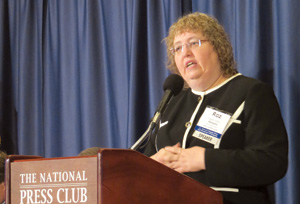Logistics Costs Rise to $1.45 Trillion in 2014, Highest Level Since Before the Recession

WASHINGTON — The cost of moving and storing goods in the United States rose 3.1% in 2014 from a year earlier to $1.45 trillion, the highest level since before the recession, according to the State of Logistics report presented by the Council of Supply Chain Management Professionals on June 23.
Logistics costs as a percentage of gross domestic product slipped to 8.3% in 2014 from 8.4% in 2013. In 2007, when spending on transportation and warehousing previously peaked at $1.42 trillion, it was 9.8%.
Total logistics costs fell to $1.11 trillion during the depths of the recession and has been rising in line with slow economic growth since 2009.
The cost of transportation, which includes goods moving by highway, rail, water, air and pipeline, increased 3.6% to a record $901 billion in 2014 from $885 billion in 2013, according to data compiled by Rosalyn Wilson, a senior business analyst with Parsons Corp. and author of the report.
Trucking accounts for the biggest share of transportation costs, with spending on local and intercity freight hauls rising 7% to $702 billion in 2014 from $657 billion in 2013.
Wilson said freight volume is expected to continue growing at a moderate rate in 2015 but that capacity is not going to keep pace.
“It is likely that most of the freight logistics industry’s problems over the next three years will relate to capacity issues,” Wilson said. “For 2015 specifically, industry experts expect bottlenecks across almost every mode of transport.”
Concern about freight hauling capacity is fueling growth in the use of third-party logistics companies, Wilson said. It is also spurring the adoption of technology to improve efficiency and productivity for drivers and equipment used to transport goods, according to participants in a panel discussion after the release of the report.
“We’re seeing hybrid solutions in which shippers are using dedicated contact carriage and developing closer relationships with carriers,” said Joe Carlier, senior vice president of global sales for Penske Logistics in Reading, Pennsylvania.
Wilson said spending on third-party logistics services increased 7.4% to $157.2 billion in 2014 and is projected to rise 5.7% to $166.1 billion in 2015, based on estimates provided by Armstrong & Associates Inc., a logistics research firm based in West Allis, Wisconsin.
Mary Long, vice president of logistics and network planning for Domino’s Pizza, said her company, based in Ann Arbor, Michigan, is expanding its private fleet of 220 trucks and is making use of sensor technology to improve load forecasting for goods delivered to its 11,700 pizza stores in the United States and Canada.
At Boeing Co., Shawn Wattles, director of supply chain logistics, said the Chicago-based aerospace firm is going deeper into its list of freight service providers to find capacity as carriers find more lucrative freight to haul and pass on pickups at Boeing.
“We’re seeing challenges,” Wattles said.
Boeing is ramping up production rates and is taking steps to better track global shipments of parts and materials, he said.
Dean Wise, vice president of network strategy at BNSF Railway, said congestion problems on the railroad have eased, but agriculture producers are facing problems because the higher value of the U.S. dollar has diminished demand for exports of food products and storage elevators are still full with record harvests from last year.
“We see increased shipments from ports on the Gulf of Mexico for chemicals and LNG exports,” Wise said.
Ron Marotta, vice president at Yusen Logistics in Secaucus, New Jersey, said ports are looking for ways to speed up loading and unloading of containers as ocean carriers use bigger ships to save on fuel.
Marotta said he sees more use of automated systems at ports to keep goods moving.

